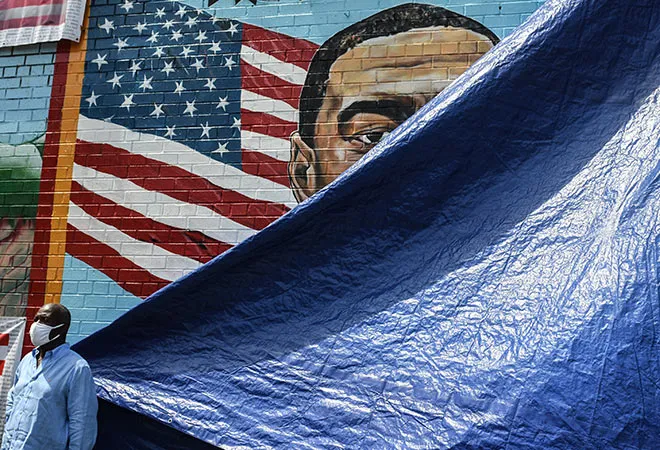
Since the al-Qaeda terrorist attacks of September 11, 2001, the word terrorism in the United States has been nearly synonymous with a specific kind of terrorism—Salafi jihadism. In other words, even though terrorism is politically and/or ideologically motivated violence, Americans and the U.S. government were almost wholly consumed by and narrowly focused on the threat posed by groups like al-Qaeda and the Islamic State in Iraq and Syria (ISIS), and concerned with those Americans living on U.S. soil who were motivated by these organizations to conduct attacks.
The focus on al-Qaeda and Salafi-jihadist more broadly was understandable, as the United States was caught off guard on 9/11, Americans were shocked and traumatized, and the nation subsequently mobilized to launch the (poorly named) Global War on Terrorism (GWOT). Less than three years after invading Afghanistan in an effort to destroy al-Qaeda and topple the Afghan Taliban, the United States invaded Iraq, overthrew Saddam Hussein, and soon became mired in a bloody counterinsurgency that gave rise to al-Qaeda in Iraq (AQI), the predecessor organization of ISIS.
The United States scored some impressive victories fighting against transnational terrorist organizations. A relentless drone campaign decimated the ranks of al-Qaeda’s leadership. And a sustained, multilateral coalition helped to destroy the ISIS caliphate, although the group continues to rebuild itself as a decentralized network across swaths of Syria and Iraq.
The United States scored some impressive victories fighting against transnational terrorist organizations. A relentless drone campaign decimated the ranks of al-Qaeda’s leadership. And a sustained, multilateral coalition helped to destroy the ISIS caliphate, although the group continues to rebuild itself as a decentralized network across swaths of Syria and Iraq.
Domestically, the United States was left to contend with attacks by violent extremists and Salafi-jihadists inspired by al-Qaeda and ISIS propaganda. In April 2013, two brothers learned to build bombs from al-Qaeda in the Arabian Peninsula’s (AQAP) Inspire magazine and went on to attack the Boston Marathon, killing three people and injuring more than 264 others. In December 2015, a husband and wife pledged allegiance to ISIS leader Abu Bakr al-Baghdadi before killing 14 people and injuring another 21 in San Bernardino, California. Approximately six months later, an individual pledged allegiance to Baghdadi before slaughtering 49 people and wounding dozens more in an attack on a gay nightclub in Orlando, Florida. Several other attacks took place over the years, including a vehicle ramming attack in New York City that killed eight and injured eleven more. The perpetrator showed no remorse and gleefully flaunted his admiration for IS.
But as American citizens became fixated on the very real and difficult to counter threat from Salafi-jihadists, something else was happening in parallel. It was occurring against the backdrop of the GWOT and even though it was clearly terrorism, it was dismissed, overlooked, and explained away because it wasn’t considered the real threat that Osama bin Laden had so ingrained on the psyche of the nation.
This other threat was that posed by far-right extremists, including violent white supremacists. At the so-called “Unite the Right” rally in Charlottesville, Virginia in August 2017, hundreds of torch-bearing white nationalists marched through the city in a show of force that surprised many Americans. During the protests and counter-protests, a neo-Nazi drove into a crowd of people and killed one, a young woman named Heather Heyer. In the aftermath of the melee, U.S. President Donald Trump drew sharp criticism for his portrayal of events, noting that there were “very fine people, on both sides,” after being pressed to condemn neo-Nazis and white supremacists. As terrorism expert Daniel Byman has noted, “in the United States right-wing terrorism is potentially worse than other form, because it taps into broader political tensions and because Trump’s reaction exacerbates the problems.”
There were several other high-profile incidents involving far-right extremists, including a shooting at the Tree of Life synagogue by a white supremacist targeting Jewish worshippers in October 2018. That attack, which incidentally took place in the Squirrel Hill neighborhood of Pittsburgh, Pennsylvania where the author lived for ten years (including at the time of the attack), left eleven dead and six more injured. An attack in El Paso, TX by a person targeted Hiics killed 22 people and injured more than two dozen more.
There were several other high-profile incidents involving far-right extremists, including a shooting at the Tree of Life synagogue by a white supremacist targeting Jewish worshippers in October 2018.
Moreover, U.S.-based neo-Nazis and white supremacists maintain international connections to groups based overseas, including those in Scandinavia, Ukraine, and Russia, among other places. In April 2020, for the first time ever, the United States Department of State labeled the Russian Imperial Movement (RIM) as a Specially Designated Global Terrorist entity, slapping its leadership with sanctions. Other far-right extremists groups such as The Base, the Azov Battalion, or the Atomwaffen Division could be next to be sanctioned.
According to a recent report from the Center for Strategic and International Studies (CSIS), right-wing extremists were responsible for more than two-thirds of attacks and plots in the United States in 2019, and in roughly the first half of 2020 (up to early May), right-wing extremists have accounted for an estimated 90 percent of attacks and plots. When people ask the question, how did the United States finally come to recognize the threat posed by violent white supremacists and far-right extremists operating within its borders as terrorism, and not a local issue to be handled by law enforcement, the answer is: it became far too deadly for policymakers to ignore, try as they might.
Domestically, the terrorist threat posed by far-right extremists is perhaps more diverse than ever before, comprised of an eclectic mix of neo-Nazis, anti-government militias, and conspiracy theorists. The so-called “Boogaloo Bois” represent the new generation of domestic terrorism in the United States. Less a group than an ideology connected by a shared antipathy for law enforcement, there have been a number of attacks and plots by self-described members of this movement in the first half of 2020, and many of those arrested have ties to the U.S. military.
To its credit, to account for the changing nature of the threat posed to the U.S. homeland, the Department of Homeland Security created a new label for the threat posed by far right extremists and others motivated by race or ethnicity — racially and ethnically motivated violent extremists, or REMVE. One commonly cited critique of the category is that it lumps together white supremacists with Black Identity extremists, including the so-called “Black Israelites,” and thus distorts the severity of the threat posed by the latter.
The COVID-19 crisis and coronavirus pandemic have been somewhat of an extremist’s buffet, offering groups across the ideological spectrum the opportunity to push propaganda and fit the crisis into their existing worldviews. White supremacy extremist groups in the United States have been actively recruiting new members during the pandemic, including members of increasingly younger ages.
The COVID-19 crisis and coronavirus pandemic have been somewhat of an extremist’s buffet, offering groups across the ideological spectrum the opportunity to push propaganda and fit the crisis into their existing worldviews
The nationwide protests against police brutality in the wake of the murder of George Floyd by a Minneapolis, Minnesota police officer has reenergized the Black Lives Matter (BLM) Movement. Across the United States, BLM protests have been targeted by vehicle attacks, including an attack in Richmond, Virginia by the leader of a local Ku Klux Klan chapter. Discussions about banning the Confederate flag, renaming U.S. military bases long named after Confederate generals (e.g. Fort Bragg, Fort Hood), and removing statues and monuments tied to America’s racist history are almost certain to evoke a reaction from white supremacists who see the country’s political and cultural zeitgeist shifting and are desperate to prevent change.
Too often in the United States, the knee-jerk response to questions about what to do about neo-Nazis, white supremacists, and other far-right extremists (after all, the United States lacks an official domestic terrorism law) is “what about Antifa?” in reference to the decentralized collective of anti-fascist activists known for vandalism and the destruction of property. Sadly, President Trump and his allies have politicized the domestic terrorism debate, pushing for Antifa to be designated as a domestic terrorist group, while mostly remaining silent on the growing threat posed by violent far-right extremists.
What can the debate about terrorism the United States tell us, if anything about the debate elsewhere? Unfortunately, the lesson seems to be that when terrorism is perpetrated by the majority group against a minority (racial, religious, ethnic, etc.), for the issue to be properly recognized, it needs to become so large that it’s impossible to ignore. And that takes a long time and is no guarantee. A lot of people will die in the process and during that time, movements may congeal into more coherent groups and organizations, especially if there is a sense of tacit acceptance by the state.
Other countries — including India — that have been plagued by a particular type of terrorism should take heed. Focusing on one specific threat at the expense of others could result in the threat growing so severe that it can no longer be managed. Indeed, it is possible to consider all threats, rank them according to how dangerous they are, and begin taking the necessary measures to ensure that they do not threaten the lives of civilians and the stability of the nation.
The views expressed above belong to the author(s). ORF research and analyses now available on Telegram! Click here to access our curated content — blogs, longforms and interviews.




 PREV
PREV


